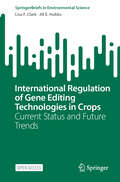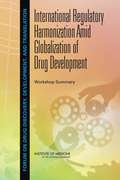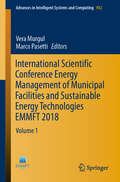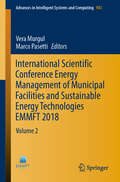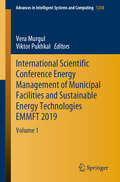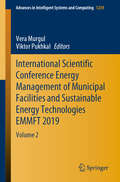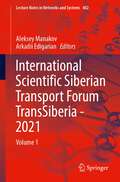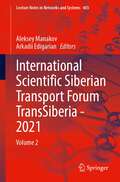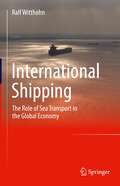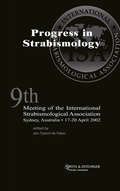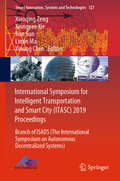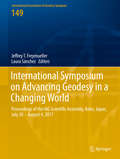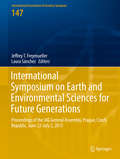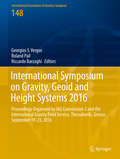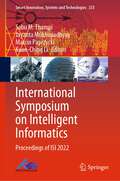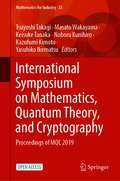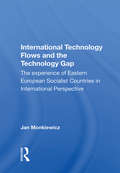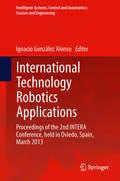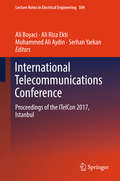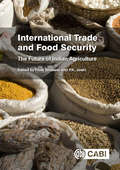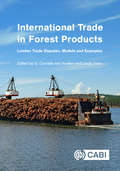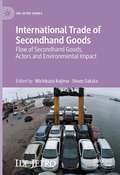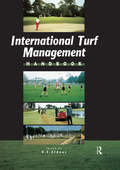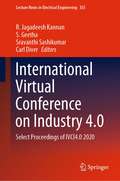- Table View
- List View
International Regulation of Gene Editing Technologies in Crops: Current Status and Future Trends (SpringerBriefs in Environmental Science)
by Jill E. Hobbs Lisa F. ClarkThis open access book analyzes the regulation and governance of gene editing in the global agrifood system as applications of gene editing, regulations and the intellectual property landscape continue to evolve. The primary focus of the manuscript is the dynamic interactions between regulatory frameworks and agricultural applications of gene editing in plant breeding. The goal is to give readers a holistic perspective on why the status of gene editing in agricultural applications is in a state of flux in some jurisdictions (e.g., the European Union) while more settled in others (e.g., Canada). Readers are provided with a clearer picture of what the future might hold for the use of gene editing in agriculture as a means to address food insecurity as the climate crisis grows and amid global geopolitical and economic turbulence.
International Regulatory Harmonization Amid Globalization of Drug Development
by Institute of Medicine Victoria Weisfeld Board on Health Sciences Policy Tracy A. Lustig Forum on Drug Discovery, Development, and TransitionThe past several decades have been a time of rapid globalization in the development, manufacture, marketing, and distribution of medical products and technologies. Increasingly, research on the safety and effectiveness of new drugs is being conducted in countries with little experience in regulation of medical product development. Demand has been increasing for globally harmonized, science-based standards for the development and evaluation of the safety, quality, and efficacy of medical products. Consistency of such standards could improve the efficiency and clarity of the drug development and evaluation process and, ultimately, promote and enhance product quality and the public health. To explore the need and prospects for greater international regulatory harmonization for drug development, the IOM Forum on Drug Discovery, Development, and Translation hosted a workshop on February 13-14, 2013. Discussions at the workshop helped identify principles, potential approaches, and strategies to advance the development or evolution of more harmonized regulatory standards. This document summarizes the workshop.
International Scientific Conference Energy Management of Municipal Facilities and Sustainable Energy Technologies EMMFT 2018: Volume 1 (Advances in Intelligent Systems and Computing #982)
by Vera Murgul Marco PasettiThis book presents a collection of the latest studies on and applications for the sustainable development of urban energy systems. Based on the 20th International Scientific Conference on Energy Management of Municipal Facilities and Sustainable Energy Technologies, held in Voronezh and Samara, Russia from 10 to 13 December 2018, it addresses a range of aspects including energy modelling, materials and applications in buildings; heating, ventilation and air conditioning systems; renewable energy technologies (photovoltaic, biomass, and wind energy); electrical energy storage; energy management; and life cycle assessment in urban systems and transportation.The book is intended for a broad readership: from policymakers tasked with evaluating and promoting key enabling technologies, efficiency policies and sustainable energy practices, to researchers and engineers involved in the design and analysis of complex systems.
International Scientific Conference Energy Management of Municipal Facilities and Sustainable Energy Technologies EMMFT 2018: Volume 2 (Advances in Intelligent Systems and Computing #983)
by Vera Murgul Marco PasettiThis book presents a collection of the latest studies on and applications for the sustainable development of urban energy systems. Based on the 20th International Scientific Conference on Energy Management of Municipal Facilities and Sustainable Energy Technologies, held in Voronezh and Samara, Russia from 10 to 13 December 2018, it addresses a range of aspects including energy modelling, materials and applications in buildings; heating, ventilation and air conditioning systems; renewable energy technologies (photovoltaic, biomass, and wind energy); electrical energy storage; energy management; and life cycle assessment in urban systems and transportation.The book is intended for a broad readership: from policymakers tasked with evaluating and promoting key enabling technologies, efficiency policies and sustainable energy practices, to researchers and engineers involved in the design and analysis of complex systems.
International Scientific Conference Energy Management of Municipal Facilities and Sustainable Energy Technologies EMMFT 2019: Volume 1 (Advances in Intelligent Systems and Computing #1258)
by Vera Murgul Viktor PukhkalThis book contains the results of the latest research on energy-related topics in transportation, economics, and management. The book is composed of select research proceedings of the EMMFT 2019 conference, and covers such issues as energy efficiency in the transport sector, infrastructure, mobile equipment, rail transportation safety and reliability assessment methods, communication and signal, traction power supply, operation organization, and modeling unique transport scenarios. This book also gathers cutting-edge studies on the relationship between energy innovations and economic growth, the impacts of globalization and energy policies of countries on economics and environmental quality, and design and analysis of energy management systems. This book is of considerable interest to engineers, scientists, graduate students, and researchers in the field of transportation engineering, as well as to professionals working in the energy industries. It is also of use to employees and investors concerned with energy management, including utilities and industry professionals, and regulators.
International Scientific Conference Energy Management of Municipal Facilities and Sustainable Energy Technologies EMMFT 2019: Volume 2 (Advances in Intelligent Systems and Computing #1259)
by Vera Murgul Viktor PukhkalThis book is intended to assist to improve energy efficiency in the industrial sector. The book offers case studies for industrial energy efficiency improvement and contains brief reports on cutting-edge research in all fields of the energy industry. This book, which is composed of select research proceedings of the EMMFT 2019 conference, covers such issues as: good quality energy use, energy generation technologies, materials used for energy generation, and storage technologies, as well as materials for water purification, petroleum engineering, and digital energy systems. The case studies discussed comprise the use of fossil fuel and non-fossil fuel energy resources, novel materials with advanced heat transport or heat resistance, and energy digitalization. Coverage extends to all theoretical and applied aspects of the field. This book is an ideal resource for scientists and energy analysts, industrial practitioners, engineers, researchers, and postgraduate students working in the field of management and technology for improving energy efficiency in the industry. Also, the book is of interest to researchers, engineers, and laboratory personnel in the fields of power systems and smart grids.
International Scientific Siberian Transport Forum TransSiberia - 2021: Volume 1 (Lecture Notes in Networks and Systems #402)
by Aleksey Manakov Arkadii EdigarianThe book presents latest developments in the field of high-speed railway, Hyperloop transportation technologies and Maglev system. In recent years, railway transport has received a powerful impetus in its development. With the advent of the 4th Industrial revolution, the transport sector is moving towards full digitalization. TransSiberia is a platform where both the rail industry and the communications industry can meet and converge. The book contains papers prepared by experts from both sectors. This is primarily research in the field of the ICT technologies, which will be used for the future railway system. The results of studies on the design of intelligent autonomous transport systems and the operation of high-speed railways in the harsh weather conditions of Siberia are presented in detail. The book presents the state of the art in smart grid technology for railway power systems. This will contribute to decarbonization of the railway. The presented technical innovations in railway science and engineering will help scientists and engineers create a new generation of trains running on alternative fuels and capable of functioning without interruptions in any climatic conditions.
International Scientific Siberian Transport Forum TransSiberia - 2021: Volume 2 (Lecture Notes in Networks and Systems #403)
by Aleksey Manakov Arkadii EdigarianThis book presents innovations in the field of high-speed rail technology, hyperloop transportation technologies and Maglev system, information and communication technology (ICT) for intelligent transportation systems (ITS), multimodal transportation, sustainable freight transportation, and others.The papers presented in the book are proceedings of the annual scientific forum “TransSiberia”, which is the foremost Russian transport event that focuses on innovations in rail transport. The book also presents research in the field of railway engineering, health monitoring, inspection, NDT&E, and signal processing. Developments in the field of decarbonization of railway transport and new types of fuel as an alternative to electrification are proposed.The issues of sustainable operation and maintenance of railway systems and sustainable freight transportation, such as digitalization and AI technologies for sustainable asset management, operation, and maintenance of railway systems, have received a lot of research attention.The book serves as a medium for railroad academia and industry to exchange new ideas and share the latest achievements, as well as to continue supporting the productivity of the transport industry in a sustainable manner.
International Shipping: The Role of Sea Transport in the Global Economy
by Ralf WitthohnBased on thoroughly researched texts and rare photographies this book describes the actual developments of international shipping and all the facets connected to overseas good flows. Main source for the deep reaching insight into the maritime industry are authentic reports carried out at the focusses of the shipping scene. By explaining the design und purpose of nowadays ship types, the different ways of cargo handling as well as the activities of shipowners and operators is painted a representative and rich-illustrated picture of the actual maritime scene.
International Strabismological Association ISA 2002
by Jan-Tjeerd de FaberThis volume contains the proceedings of the 9th Congress of the International Strabismological Association (ISA). The meeting took place in Sydney, Australia, from 17th to 20th April 2002. The text was written with the intention to provide the reader with information on developments in observations and therapies in strabismus and paediatric ophthalmology. The format of the work follows the meeting programme and is divided into sections of oral presentations, manuscripts of the posters, symposia and workshop. In order to assist the reader a list of keywords and authors have been added to the book.
International Symposium for Intelligent Transportation and Smart City: Branch of ISADS (The International Symposium on Autonomous Decentralized Systems) (Smart Innovation, Systems and Technologies #127)
by Xiaoqing Zeng Xiongyao Xie Jian Sun Limin Ma Yinong ChenThis book presents research advances in intelligent transportation and smart cities in detail, mainly focusing on green traffic and urban utility tunnels, presented at the 4th International Symposium for Intelligent Transportation and Smart City (ITASC) held at Tongji University, Shanghai, on May 8–10, 2019. It discusses a number of hot topics, such as the 2BMW system (Bus, Bike, Metro and Walking), transportation safety and environmental protection, urban utility design and application, as well as the application of BIM (Building Information Modeling) in city design. By connecting the theory and applications of intelligent transportation in smart cities, it enhances traffic efficiency and quality. The book gathers numerous selected papers and lectures, including contributions from respected scholars and the latest engineering advances, to provide guidance to researchers in the field of transportation and urban planning at universities and in related industries.The first conference in the ITASC series was held in 2013 as a workshop of the International Symposium on Autonomous Decentralized System (ISADS) in Mexico City. The second and third were held in May 2015 and May 2017, respectively, in Tongji University, Shanghai.
International Symposium on Advancing Geodesy in a Changing World: Proceedings of the IAG Scientific Assembly, Kobe, Japan, July 30 – August 4, 2017 (International Association of Geodesy Symposia #149)
by Jeffrey T. Freymueller Laura SánchezThese proceedings contain 23 papers, which are the peer-reviewed versions of presentations made at the Joint Scientific Assembly of the International Association of Geodesy (IAG) and the International Association of Seismology and Physics of the Earth’s Interior (IASPEI). The assembly was held from 30 July to 4 August 2017 in Kobe, Japan. The scientific assembly included seven symposia organized by IAG, and nine joint symposia, along with additional symposia organized by IASPEI. The IAG symposia were structured according to the four IAG Commissions and the three GGOS Focus Areas, and included reference frames, static and time-variable gravity field, Earth rotation and geodynamics, multi-signal positioning, geodetic remote sensing, and GGOS. The joint symposia included monitoring of the cryosphere, studies of earthquakes, earthquake source processes, and other types of fault slip, geohazard warning systems, deformation of the lithosphere, and seafloor geodesy. Together, the IAG and joint symposia spanned a broad range of work in geodesy and its applications.
International Symposium on Earth and Environmental Sciences for Future Generations: Proceedings of the IAG General Assembly, Prague, Czech Republic, June 22- July 2, 2015 (International Association of Geodesy Symposia #147)
by Jeffrey T. Freymueller Laura SánchezThis book series is composed of peer-reviewed proceedings of selected symposia organized by the International Association of Geodesy. It deals primarily with topics related to Geodesy Earth Sciences : terrestrial reference frame, Earth gravity field, Geodynamics and Earth rotation, Positioning and engineering applications.
International Symposium on Gravity, Geoid and Height Systems 2016: Proceedings Organized by IAG Commission 2 and the International Gravity Field Service, Thessaloniki, Greece, September 19-23, 2016 (International Association of Geodesy Symposia #148)
by Roland Pail Riccardo Barzaghi Georgios S. VergosThese proceedings contain 27 papers, which are the peer-reviewed versions of presentations made at the International Association of Geodesy (IAG) symposium “Gravity, Geoid and Height Systems 2016” (GGHS2016). GGHS2016 was the first Joint international symposium organized by IAG Commission 2 “Gravity Field”, the International Gravity Field Service (IGFS) and the GGOS Focus Area “Unified Height System”. It took place in Thessaloniki, Greece, in September 19-23, 2016 at the premises of the Aristotle University of Thessaloniki. The symposium was organized by the Department of Geodesy and Surveying of the Aristotle University of Thessaloniki, which presently hosts the IGFS Central Bureau. The focus of the Symposium was on methods for observing, estimating and interpreting the Earth gravity field as well as its applications. GGHS2016 continued the long and successful history of IAG’s Commission 2 Symposia.
International Symposium on Intelligent Informatics: Proceedings of ISI 2022 (Smart Innovation, Systems and Technologies #333)
by Kuan-Ching Li Sabu M. Thampi Jayanta Mukhopadhyay Marcin PaprzyckiThis book constitutes thoroughly refereed post-conference proceedings of the 7th International Symposium on Intelligent Informatics (ISI 2022), from August 31 to September 1–2, 2022, Trivandrum, India. The revised papers presented are carefully reviewed and selected from several initial submissions. The scope of the Symposium includes AI, machine learning, cognitive computing, soft computing, security informatics, data science, computer vision, pattern recognition, intelligent software engineering, intelligent networked systems, IoT, cyber-physical systems, and NLP. The book is directed to the researchers and scientists engaged in various fields of intelligent informatics.
International Symposium on Mathematics, Quantum Theory, and Cryptography: Proceedings of MQC 2019 (Mathematics for Industry #33)
by Tsuyoshi Takagi Masato Wakayama Keisuke Tanaka Noboru Kunihiro Kazufumi Kimoto Yasuhiko IkematsuThis open access book presents selected papers from International Symposium on Mathematics, Quantum Theory, and Cryptography (MQC), which was held on September 25-27, 2019 in Fukuoka, Japan. The international symposium MQC addresses the mathematics and quantum theory underlying secure modeling of the post quantum cryptography including e.g. mathematical study of the light-matter interaction models as well as quantum computing.The security of the most widely used RSA cryptosystem is based on the difficulty of factoring large integers. However, in 1994 Shor proposed a quantum polynomial time algorithm for factoring integers, and the RSA cryptosystem is no longer secure in the quantum computing model. This vulnerability has prompted research into post-quantum cryptography using alternative mathematical problems that are secure in the era of quantum computers. In this regard, the National Institute of Standards and Technology (NIST) began to standardize post-quantum cryptography in 2016. This book is suitable for postgraduate students in mathematics and computer science, as well as for experts in industry working on post-quantum cryptography.
International Technology Flows And The Technology Gap: The Experience Of Eastern European Socialist Countries In International Perspective
by Jan MonkiewiczThis book assesses under what conditions and to what extent international technology transfer may contribute to technology gap closure in overall industrial activity. It is of particular interest for all developing countries as well as for the socialist countries of Eastern Europe.
International Technology Robotics Applications
by Ignacio González AlonsoThis book presents the latest scientific research related to the field of Robotics. It involves different topics such as biomedicine, energy efficiency and home automation and robotics. The book is written by technical experts and researchers from academia and industry working on robotics applications. The book could be used as supplementary material for courses related to Robotics and Domotics.
International Telecommunications Conference: Proceedings of the ITelCon 2017, Istanbul (Lecture Notes in Electrical Engineering #504)
by Ali Boyaci Ali Riza Ekti Muhammed Ali Aydin Serhan YarkanThis book collects one of the global premier scientific gatherings on telecommunications, signal processing, data networks, security, and optimization. It presents the proceedings of the International Telecommunications Conference 2017 (ITelCon 2017), held in Istanbul, Turkey from December 28 to 29, 2017. The proceedings include state-of-the-art studies that highlight major advances in the field of telecommunications and related branches. In addition, some of the contributions form the basis for 5G and beyond studies and standardization processes. The ITelCon conference brings together industry and academia participants from around the globe and promotes research, development, and applications in the field of telecommunications. It includes a far-reaching program supported by a variety of technical tracks on research, development, technology, design, services, and applications. The primary audience of ITelCon includes academics, experts and professionals from industry, as well as researchers in the field of telecommunications and relevant subfields.
International Trade and Food Security: The Future of Indian Agriculture
by Floor Brouwer P. K. JoshiThis book explores structural changes in India's agrifood systems during the next ten to twenty years. The dynamics in the agrifood sector is explored in the context of the overall economy, taking into account agricultural and trade policies and their impacts on national and global markets. The contributors draw on qualitative and quantitative approaches, using both a national model - to focus on urban-rural relations and income distribution - and an international model to focus on patterns of economic growth and international trade.
International Trade and Food Security: The Future of Indian Agriculture
by Floor Brouwer P. K. JoshiThis book explores structural changes in India's agrifood systems during the next ten to twenty years. The dynamics in the agrifood sector is explored in the context of the overall economy, taking into account agricultural and trade policies and their impacts on national and global markets. The contributors draw on qualitative and quantitative approaches, using both a national model - to focus on urban-rural relations and income distribution - and an international model to focus on patterns of economic growth and international trade.
International Trade in Forest Products: Lumber Trade Disputes, Models and Examples
by Craig Johnston Harry Nelson Joseph Buongiorno Jinggang Guo Xintong Li Fatemeh Mokhtarzadeh Prakash Nepal Jeffrey Prestemon Brad StennesBecause of the long-standing Canada-U.S. lumber trade dispute and the current pressure on the world's forests as a renewable energy source, much attention has been directed toward the modelling of international trade in wood products. Two types of trade models are described in this book: one is rooted in economic theory and mathematical programming, and the other consists of two econometric/statistical models--a gravity model rooted in theory and an approach known as GVAR that relies on time series analyses. The purpose of the book is to provide the background theory behind models and facilitate readers in easily constructing their own models to analyse policy questions that they wish to address, whether in forestry or some other sector. Examples in the book are meant to illustrate how models can be used to say something about a variety of issues, including identification of the gains and losses to various players in the North American softwood lumber business, and the potential for redirecting sales of lumber to countries outside the United States. The discussion is expanded to include other products besides lumber, and used to examine, for example, the effects of log export restrictions by one nation on all other forestry jurisdictions, the impacts of climate policies as they relate to the global forest sector, and the impact of oil prices on forest product markets throughout the world. This book will appeal to practising economists and researchers who wish to examine various policies that affect international trade, whether their interest is local or international in scope. Because the book provides the theoretical bases underlying various models, students and practitioners will find this a valuable reference book or supplementary textbook.
International Trade of Secondhand Goods: Flow of Secondhand Goods, Actors and Environmental Impact (IDE-JETRO Series)
by Shozo Sakata Michikazu KojimaThis book demonstrates the flow of the international trade of secondhand goods and examines the socio-economic background and mechanisms of the trade. It highlights the actors involved in the trade of secondhand goods and how traditionally secondhand good have largely been traded through social or ethnic networks in order to effectively transfer quality and market information. The development of information technology and emergence of new information platforms have changed these business models. The policies and regulations relating to the trade of secondhand goods are explored, alongside the negative impact of these trades, and the growing awareness of the circular economy. This book illustrates how importing countries as well as international institutions have developed regulations in order to balance these two issues. It will relevant to students and economists interested in development economics and economics geography.
International Turf Management
by David AldousMany leisure activities involve the use of turf as a surface. Grass surfaces on golf courses, bowling clubs, cricket pitches, racetracks, and parks all require maintenance by trained personnel. International Turf Management Handbook is written by a team of international experts. It covers all aspects of turf management and in particular* the selection and establishment of grass varieties* soils, irrigation and drainage* performance testing and playing qualities* issues relating to specific playing surfaces In its depth of coverage and detailed practical advice from around the world this comprehensive handbook is destined to become the standard reference work on the subject.
International Virtual Conference on Industry 4.0: Select Proceedings of IVCI4.0 2020 (Lecture Notes in Electrical Engineering #355)
by S. Geetha R. Jagadeesh Kannan Sravanthi Sashikumar Carl DiverThis book presents the proceedings of the International Virtual Conference on Industry 4.0 (IVCI4.0 2020). This conference brings together specialists from the academia and industry sectors to promote the exchange of knowledge, ideas, and information on the latest developments and applied technologies in the field of Industry 4.0. The book discusses a wide range of topics such as the design of smart and intelligent products, developments in recent technologies, rapid prototyping and reverse engineering, multistage manufacturing processes, manufacturing automation in the Industry 4.0 model, cloud-based products, and cyber-physical and reconfigurable systems, etc. The volume supports the transfer of vital knowledge to the next generation of academics and practitioners.
